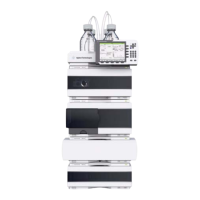34 1260 Infinity Micro Degasser Service Manual
4 Using the Micro Vacuum Degasser
Solvent Information
Solvent Information
The information in this section applies to a complete system including
stainless steel capillaries and is not limited to the module described in
this manual. Exceptions may apply for some modules (e.g. Bio- inert
system, detector flow cells etc.). For details, please refer to manuals of
those modules.
Always filter solvents through 0.4 µm filters, small particles can
permanently block the capillaries and valves. Avoid the use of the
following steel- corrosive solvents:
• Solutions of alkali halides and their respective acids (for example,
lithium iodide, potassium chloride, and so on).
• High concentrations of inorganic acids like sulfuric and nitric acid,
especially at higher temperatures (replace, if your chromatography
method allows, by phosphoric acid or phosphate buffer which are less
corrosive against stainless steel).
• Halogenated solvents or mixtures which form radicals and/or acids, for
example:
2CHCl
3
+ O
2
–> 2COCl
2
+ 2HCl
This reaction, in which stainless steel probably acts as a catalyst,
occurs quickly with dried chloroform if the drying process removes the
stabilizing alcohol.
• Chromatographic grade ethers, which can contain peroxides (for
example, THF, dioxane, di- isopropylether). Such ethers should be
filtered through dry aluminium oxide which adsorbs the peroxides.
• Mixtures of carbon tetrachloride with 2- propanol or THF dissolve
stainless steel.
Material Information
Materials in Flow Path
Following materials are used in the flow path of this module:

